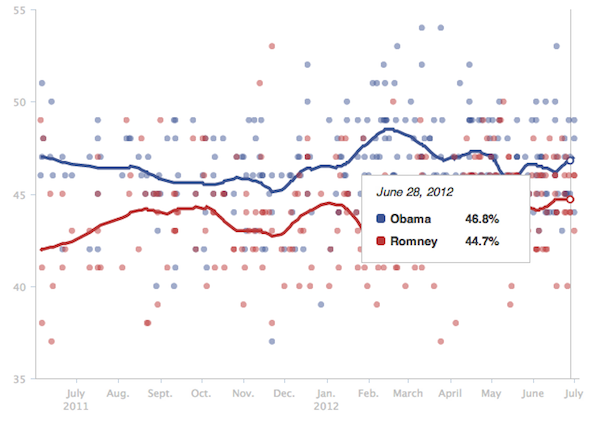
Developers and election watchers take note: The Huffington Post just released a polling data API. The Huffpost Pollster API will allow anyone to dig into more than 13,000 opinion polls on the presidential election as well as U.S. House and Senate races.
The data will allow journalists, developers, and researchers the ability to fetch data from the surveys for their own apps or data-crunching purposes. And the API includes not just results but the full questions and responses, allowing users to dig deep into polling methodology. Andrei Scheinkman, interactive news editor for The Huffington Post, told me the API includes more than 200,000 responses. Instead of just getting raw numbers for X would vote for Mitt Romney and Y would vote for Barack Obama, the API includes responses to questions like, “In general, how satisfied are you with the way things are going in the nation today?”
Here are some of the nerdy basics:
We’re publishing the data as an HTTP-based application programming interface, or API, with JSON and XML responses. For researchers, journalists or anyone who might have trouble using an API, we will soon make the data available through Atom feeds and Excel-ready CSVs.
This is the Huffington Post’s first public API. The data comes from poll aggregator Pollster, which HuffPost acquired in 2010 and has since used to power its political reporting and interactive features. For app creators, the good news is it’s completely open — no strings attached to the data and no penalties for heavy users. The API will be updated as new polls come in during the campaign season. It’s easy to see how the API could lead to dozens of new poll trackers and visualizations that can parse things like geography, party affiliation, and specific campaign issues.
Scheinkman compares the Pollster API to the New York Times congressional API or USA Today’s Census API. All three offer up raw numbers for people to play with, not a database of stories, headlines, or any refined content. “The publishing of the API is an act of journalism,” he told me. “It adds some accessibility and transparency about the world.”
The pollster API could prove to be valuable by sharing the basic horse-race numbers we expect to see in elections, but also providing a deeper understanding of how polls are conducted. If you’re a news organization, that means you get to double down on story possibilities. Scheinkman said the API was designed in part to help demystify the polling process. “I think our main motivation was up till now polling data, while publicly available, was not that accessible,” Scheinkman said.
These are busy times for Arianna Huffington’s media company. There was the Pulitzer win, the debut of the magazine, and, later this summer, a new streaming video network. The API is yet another move to bring the company in line with big names like The New York Times, USA Today, NPR, and the Guardian, all of whom provide an API for software makers. “Letting people use the Huffington Post as a platform to build on is something we’re interested in and excited about,” he said.
Correction: This story originally stated NPR’s API was only available to member stations. The full API is available to public.